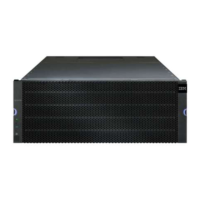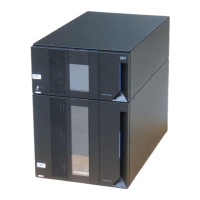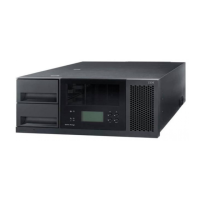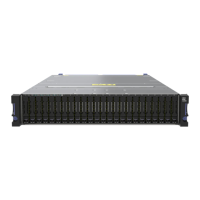Notes
Each disk pool name must be unique. You can use any combination of alphanumeric characters,
underscore (_), hyphen(-), and pound (#) for the user label. User labels can have a maximum of 30
characters.
If the parameters you specify cannot be satisfied by any of the available candidate drives, the command
fails. Normally, all drives that match the quality of service attributes will be returned as the top
candidates. However, if you specifying a drive list, some of the available drives returned as candidates
might not match the quality of service attributes.
If you do not specify a value for an optional parameter, a default value is assigned.
Drives
When you use the driveType parameter, all of the unassigned drives that are of that drive type are used
to create the disk pool. If you want to limit the number of drives found by the driveType parameter in
the disk pool, you can specify the number of drives using the driveCount parameter. You can use the
driveCount parameter only when you use the driveType parameter.
The drives parameter supports both high-capacity drive expansion enclosures and low-capacity drive
expansion enclosures. A high-capacity drive expansion enclosure has drawers that hold the drives. The
drawers slide out of the drive expansion enclosure to provide access to the drives. A low-capacity drive
expansion enclosure does not have drawers. For a high-capacity drive expansion enclosure, you must
specify the identifier (ID) of the drive expansion enclosure, the ID of the drawer, and the ID of the slot in
which a drive resides. For a low-capacity drive expansion enclosure, you need only specify the ID of the
drive expansion enclosure and the ID of the slot in which a drive resides. For a low-capacity drive
expansion enclosure, an alternative method for identifying a location for a drive is to specify the ID of
the drive expansion enclosure, set the ID of the drawer to 0, and specify the ID of the slot in which a
drive resides.
If you enter specifications for a high capacity drive expansion enclosure, but a drive expansion enclosure
is not available, the storage management software returns an error message.
Disk Pool Alert Thresholds
Each disk pool has two progressively severe levels of alerts to inform users when the storage capacity of
the disk pool is approaching full. The threshold for an alert is a percent of the used capacity to the total
usable capacity in the disk pool. The alerts are:
v Warning - This is the first level of alert that the used capacity in a disk pool is approaching full. When
the threshold for the warning alert is reached a Needs Attention condition is generated and an event is
posted to the storage management software. The warning threshold is superseded by the critical
threshold. The default warning threshold is 50 percent.
v Critical - This is the most severe level of alert that the used capacity in a disk pool is approaching
full. When the threshold for the critical alert is reached a Needs Attention condition is generated and
an event is posted to the storage management software. The warning threshold is superseded by the
critical threshold. The default critical warning threshold is 85 percent.
To be effective, the value for a warning alert must always be less than the value for a critical alert. If
the value for the warning alert is the same as the value for a critical alert, only the critical alert is
sent.
Chapter 3. Script Commands 3-69

